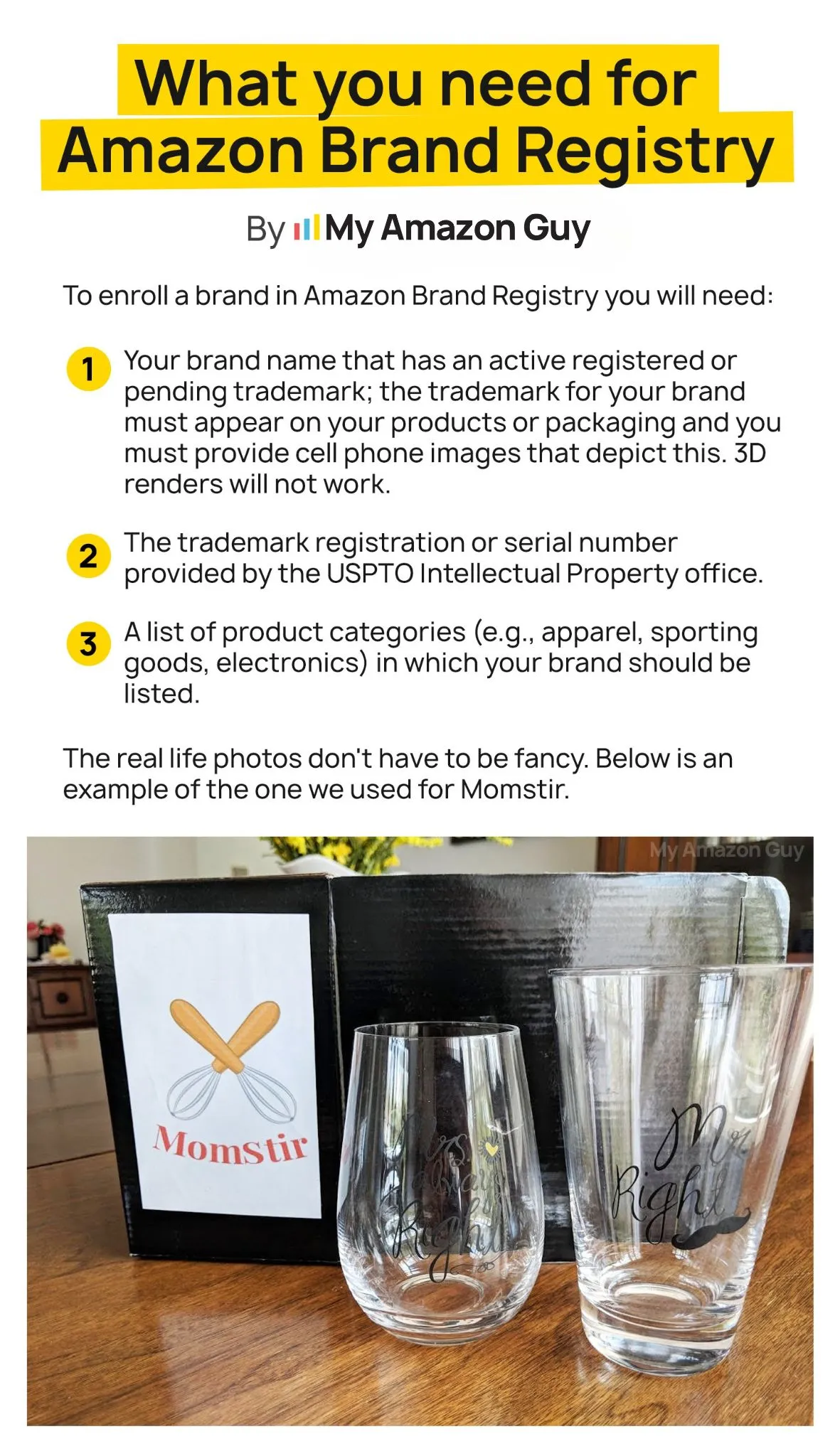
Revoked Amazon Brand Registry? Here’s Your 5-Step Fight-Back Plan.


Table of Contents
- Why Amazon Sellers Need Brand Registry
- Key Benefits of Brand Registry
- What Happens If Brand Registry Is Revoked?
- Understand what caused the revoked Amazon Brand Registry
- Strategize a plan of action to recover the revoked Brand Registry
- Resolve the Underlying Issue
- Gather Supporting Documentation
- Submit the Appeal
- Monitor the Appeal Progress
- Follow-Up with Amazon Support
- Marketing strategies to recover lost sales from revoked Amazon Brand Registry
- 1. Double Down on Amazon PPC Advertising
- 2. Optimize Your Product Listings
- 3. Leverage External Traffic
- 4. Protect Your Listings from Hijackers
- 5. Use Lightning Deals & Coupons
- 6. Rebuild Customer Trust & Brand Presence
- Proactively prevent Amazon Brand Registry revocation
- Maintain a Valid and Active Trademark
- Regularly Check Trademark Status
- Ensure Correct Trademark Ownership
- Register a Trademark Before Enrolling
- Follow All Amazon Policies Strictly
- Avoid Listing Violations
- Monitor Customer Complaints
- Protect Your Brand from Counterfeit and IP Violations
- Monitor for Counterfeit Products
- Respect Intellectual Property (IP) Rights
- Keep Your Brand Registry Information Updated
- Verify and Update Business Information Regularly
- Designate a Brand Registry Contact
- Ensure Product Compliance with Amazon’s Standards
- Meet Amazon’s Product Quality Standards
- Avoid False or Misleading Claims
- Monitor Seller Accounts & Third-Party Affiliates
- Avoid Running Multiple Seller Accounts Illegally
- Vet Authorized Third-Party Sellers
- Watch for Fraud & Security Risks
- Monitor Account Activity for Unusual Changes
- Avoid Suspicious or Fraudulent Activity
- Respond to Amazon’s Requests Quickly
- Bounce Back Strong, Recover from a Revoked Amazon Brand Registry
Revoked Amazon Brand Registry got you down? Time to pick up the pieces and bounce back like a pro.
Imagine this: You’ve done your best to get verified with Amazon Brand Registry. One minute, you’re using Helium 10 to optimize listings, confident you’re protected. The next, your revoked Amazon Brand Registry hits you like a sucker punch.
Amazon enforces its policies without warning. If you’re caught in the crossfire, whether due to a trademark dispute, missing documentation, or an unexpected policy change, you could lose months of progress.
But here’s the good news: You’re not stuck. This guide will show you why Amazon pulled the plug, how to stop it from happening again, and, if you’re already in the penalty box, how to claw your way back.
Let’s get your brand back where it belongs.
Why Amazon Sellers Need Brand Registry
Getting approved for Amazon Brand Registry can be challenging if your trademark isn’t fully registered, your brand information is inaccurate, or you fail to meet Amazon’s strict requirements.

Amazon’s Brand Registry is essential for protecting your brand, enhancing listings, and accessing exclusive tools. It helps sellers boost sales, prevent hijackers, and improve customer trust.
Key Benefits of Brand Registry
- A+ Content for Higher Conversions
Sellers can add premium images, comparison charts, and brand stories to product pages, leading to higher conversions.
Example: A kitchenware brand using A+ Content saw a 15% sales increase after adding lifestyle images and product details. - Custom Brand Storefront
Create a dedicated Amazon store to showcase your entire catalog, boosting brand loyalty and cross-sales.
Example: A skincare brand’s storefront helped customers explore its full range, increasing repeat purchases. - Stronger Counterfeit Protection
Brand Registry provides anti-counterfeiting tools to remove unauthorized sellers and protect your reputation.
Example: A shoe brand quickly removed a hijacker selling counterfeit versions of its best-selling sneakers. - Better Control Over Listings
Brand owners can prevent unauthorized edits to titles, descriptions, and images, ensuring accuracy. - Access to Exclusive Amazon Features
- Sponsored Brands ads – Run headline ads to boost visibility.
- Brand Analytics – Gain customer insights for smarter marketing.
- Vine Program – Get early reviews from trusted reviewers.
What Happens If Brand Registry Is Revoked?
Losing Brand Registry can hurt sales and brand control:
- No A+ Content – Product pages become less engaging.
- No Brand Store – Customers can’t easily browse your catalog.
- Weaker Protection – Counterfeiters may hijack your listings.
- Limited Features – Miss out on advanced advertising and insights.
Understand what caused the revoked Amazon Brand Registry
Review the revocation email and any related notifications from Amazon. Identify the specific reason(s) for the revocation (e.g., trademark issues, policy violations).
- Incorrect or Expired Trademark: If your trademark is not registered or has expired, Amazon may revoke your Brand Registry access.
- Non-Compliant Trademark Ownership: The trademark must be owned by the brand submitting it to Amazon’s Brand Registry. If Amazon finds discrepancies or issues with ownership, they may revoke your status.
- Inaccurate Brand Information: If you fail to provide correct and complete information when registering your brand or if there is an inconsistency between your application and product listings, Amazon may revoke your registration.
- Missing or Invalid Documentation: Submitting incomplete, incorrect, or outdated documents can lead to revocation.
- Listing Policy Violations: Brands found violating Amazon’s product listing guidelines (e.g., fake reviews, misleading listings) may face revocation.
- IP Infringement: Repeated infringement claims against your brand or products may lead to revocation.
- Infringement and Counterfeiting: If Amazon detects counterfeit goods under your brand or there are too many reports of unauthorized sellers selling your products, your Brand Registry status may be revoked.
- Non-Compliance with Requests: If Amazon requests additional information or documentation to verify your brand and you fail to comply within the given timeframe, your Brand Registry can be revoked.
- Unauthorized Changes: Making changes to your brand information or product listings that violate Amazon’s policies could result in suspension or revocation of your Brand Registry access.
- Account Security Breach: If your account is suspected of fraudulent activity or any security-related breaches, Amazon may revoke access to the Brand Registry as a precaution.
- Blacklisted Attorney: Many brands are affected by Amazon’s unexplained blacklisting of attorneys. To regain your brand registry status, action is essential.
Strategize a plan of action to recover the revoked Brand Registry
Resolve the Underlying Issue
- Address any trademark or intellectual property concerns (e.g., update trademark details or resolve ownership issues).
- Ensure your listings are fully compliant with Amazon’s policies and guidelines.
- Acknowledge the issue(s) that led to revocation.
- Outline corrective measures taken to resolve the issue(s).
- Provide specific actions to prevent future violations.
Gather Supporting Documentation
- Include relevant documents like trademark registration certificates, communication with the trademark office, or proof of ownership.
- Provide any other evidence to support the resolution of the issue.
Submit the Appeal
- Access the Amazon Brand Registry portal to submit your Plan of Action.
- Ensure your POA is clear, concise, and professionally written.
- Include all necessary supporting documentation to strengthen your case.
Monitor the Appeal Progress
- Track your appeal submission status through Amazon Seller Central.
- Be prepared to provide additional information if Amazon requests it.
Follow-Up with Amazon Support
- If you don’t receive a response within the stated timeframe, follow up politely to check on the status.
- Be patient and professional in all communications.
Marketing strategies to recover lost sales from revoked Amazon Brand Registry
If your Amazon Brand Registry got revoked, your sales and brand protection likely took a hit. While you work on reinstating it, you need aggressive marketing strategies to keep revenue flowing and protect your brand.
Here are six powerful tactics to recover lost sales:
1. Double Down on Amazon PPC Advertising
Increase ad spend on Sponsored Products, Sponsored Brands, and Sponsored Display to maintain visibility.
Target high-converting keywords to compensate for lost organic ranking. Use Helium 10’s keyword tracking to adjust bids based on performance.
2. Optimize Your Product Listings
Without A+ Content, focus on crafting high-quality images, bullet points, and descriptions that drive conversions.
Add persuasive copy that highlights your brand’s uniqueness. Use backend search terms wisely to maintain search visibility.
3. Leverage External Traffic
Run Google Ads, Facebook Ads, and TikTok campaigns to drive traffic directly to your Amazon listings.
Use influencers and affiliates to promote your products. Capture emails from past customers and send them exclusive deals.
4. Protect Your Listings from Hijackers
Monitor your ASINs daily using tools like Helium 10’s Alerts to detect unauthorized sellers.
Set up pricing alerts to catch suspicious price drops. Report counterfeiters aggressively through Amazon’s Report a Violation tool.
5. Use Lightning Deals & Coupons
Run Lightning Deals and Amazon Coupons to boost sales velocity and regain organic ranking.
Create time-sensitive offers to encourage impulse purchases. Stack Subscribe & Save discounts for repeat customers.
6. Rebuild Customer Trust & Brand Presence
Increase social proof by requesting more reviews through Amazon’s Request a Review button.
Engage with customers on social media and answer product questions. Offer exceptional customer service to retain loyal buyers.
Proactively prevent Amazon Brand Registry revocation
Losing access to Amazon Brand Registry can devastate your business, stripping you of key brand protection tools, A+ Content, and control over your listings. The best way to avoid this nightmare is to stay ahead of the game with a proactive strategy.
Follow this plan of action to prevent Amazon from revoking your Brand Registry status.
Maintain a Valid and Active Trademark
Regularly Check Trademark Status
Ensure your trademark is active, valid, and properly registered with a recognized national trademark office (e.g., USPTO for U.S. sellers). If your trademark is set to expire soon, renew it well in advance to avoid automatic revocation.
Ensure Correct Trademark Ownership
Double-check that your trademark ownership matches the information on your Amazon Brand Registry account. If your trademark is owned by a legal entity (LLC, corporation), ensure the seller account is under the same entity name.
Register a Trademark Before Enrolling
If you’re applying for Brand Registry, make sure your trademark is fully registered (not just pending). Amazon does not accept unregistered trademarks.
Follow All Amazon Policies Strictly
Avoid Listing Violations
Do not use misleading product titles, descriptions, or images. Ensure that all claims about your products (e.g., health benefits, performance) comply with Amazon’s guidelines.
Monitor Customer Complaints
Stay on top of negative reviews and resolve customer complaints promptly. Avoid tactics like fake reviews or manipulated sales velocity, as these can trigger policy violations.
Protect Your Brand from Counterfeit and IP Violations
Monitor for Counterfeit Products
Use tools like Helium 10’s Alerts or Amazon’s Transparency Program to identify and report counterfeit listings. If you detect unauthorized sellers, file an infringement report through Amazon’s Report a Violation tool.
Respect Intellectual Property (IP) Rights
Ensure you are not unknowingly violating another brand’s trademark, copyright, or patent. If you sell private-label products, conduct a trademark search before launching to avoid legal disputes.
Keep Your Brand Registry Information Updated
Verify and Update Business Information Regularly
Keep your business address, contact details, and brand information accurate in Seller Central. If Amazon requests verification documents, respond quickly with the correct paperwork.
Designate a Brand Registry Contact
Assign a dedicated person/team to monitor Amazon’s emails and account notifications for any issues.
Ensure Product Compliance with Amazon’s Standards
Meet Amazon’s Product Quality Standards
Avoid selling defective, damaged, or non-compliant products that could trigger quality complaints. Regularly check customer feedback for potential quality concerns.
Avoid False or Misleading Claims
If your product makes health claims, eco-friendly promises, or durability guarantees, ensure you have the documentation to back them up.
Monitor Seller Accounts & Third-Party Affiliates
Avoid Running Multiple Seller Accounts Illegally
Do not create multiple Amazon seller accounts unless you have Amazon’s approval. If you operate multiple brands, register them separately under a legitimate business structure.
Vet Authorized Third-Party Sellers
If other sellers are authorized to sell your brand, ensure they follow Amazon’s policies. If an authorized seller gets flagged for violations, your Brand Registry status could be at risk.
Watch for Fraud & Security Risks
Monitor Account Activity for Unusual Changes
Regularly review your Seller Central account for any unauthorized edits to your listings, pricing, or brand details. Use two-factor authentication (2FA) to protect your account from security breaches.
Avoid Suspicious or Fraudulent Activity
Never engage in bribing customers for positive reviews, manipulating sales rankings, or selling counterfeit goods. Report any suspicious activities on your account immediately to Amazon.
Respond to Amazon’s Requests Quickly
If Amazon requests proof of trademark ownership or business verification documents, submit them before the deadline. Keep a digital file of all important business and trademark-related documents for quick access
Bounce Back Strong, Recover from a Revoked Amazon Brand Registry
Losing your Amazon Brand Registry can feel like a major setback, but with the right strategy, you can recover and protect your brand for the future.
- Identify the Cause. Review Amazon’s revocation notice to pinpoint the issue (e.g., expired trademark, policy violations, or counterfeit claims).
- Develop a Plan of Action. Address the problem, correct mistakes, and provide Amazon with a clear, well-documented appeal.
- Keep Sales Flowing. Use PPC, external traffic, and promotional deals to sustain revenue while resolving the issue.
- Protect Your Brand. Proactively monitor listings, secure trademarks, and comply with Amazon’s policies to prevent future revocations.
Act fast and stay ahead—your brand’s success depends on it.
Achieve More Results in Less Time
Accelerate the Growth of Your Business, Brand or Agency
Maximize your results and drive success faster with Helium 10’s full suite of Amazon and Walmart solutions.

